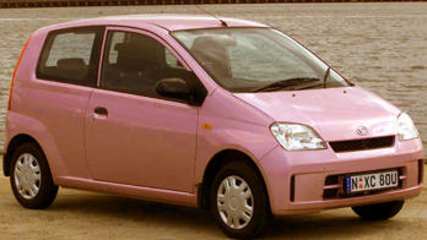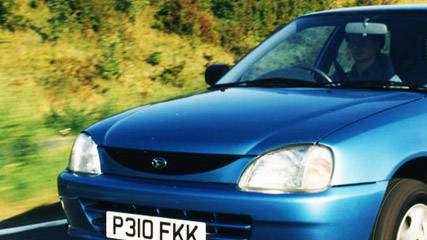Daihatsu Charade Reviews
You'll find all our Daihatsu Charade reviews right here. Daihatsu Charade prices range from $2,310 for the Charade to $3,850 for the Charade .
Our reviews offer detailed analysis of the 's features, design, practicality, fuel consumption, engine and transmission, safety, ownership and what it's like to drive.
The most recent reviews sit up the top of the page, but if you're looking for an older model year or shopping for a used car, scroll down to find Daihatsu dating back as far as 1980.
Or, if you just want to read the latest news about the Daihatsu Charade, you'll find it all here.

Used Daihatsu Charade review: 2003
Read the article
By Graham Smith · 22 Jan 2009
Toyota’s decision to pull Daihatsu from its showrooms didn’t come as a great surprise to anyone who saw the brand’s presence declining over the last few years. Where once the Charade was a popular small car choice that offered good reliable motoring at a value-for-money price, neglect allowed it to slip into decline as other small cars moved ahead. As it slipped so too did it drop off buyers radar, which can only have hastened the end.For many years the Charade was a solid little car that delivered Japanese quality at a price a touch under that of similar models in the mainstream Toyota model range.It was never a car that stood out from the crowd, but that was its great appeal for many who simply wanted no-fuss, reliable transport at an affordable price.Once the Korean makes had cut a swathe through the bottom end of our market Daihatsu was doomed. Instead of the cheap and cheerful little car it was then undercut by the cars from the Korean peninsula and didn’t have the gloss to run with the more expensive Japanese models it was by then really competing with.MODEL WATCHFor many years the Charade was just kept alive with a series of minor facelifts, a different grille here, new bumpers there and a shuffled model range was enough to make you think there really was something new.For the most part it was just window dressing, it was the same old Charade tarted up to keep sales ticking over without necessarily doing anything special.Then in 2000 Daihatsu actually dropped the name from its range. It had become tired through lack of action, and the company introduced new names and models aimed at competing with the runaway Koreans.When nothing really seemed to work the company rebirthed the old name in 2003 on an attractively styled little hatch, but it was probably too little too late to save the brand from oblivion.There was just the one model, a well-equipped three-door hatch which boasted dual front airbags along with seat belt pretensioners and force limiters, central locking, immobiliser, power mirrors and front windows, cloth trim, 60/40 split-fold rear seat, CD player. Air-conditioning and metallic paint covered the available options.Up front the Charade packed a pint-sized 40 kW punch in the form of a 1.0-litre double overhead camshaft four-cylinder engine, but when it only has to move 700 kg it was sufficient to make it zippy. In other words it was perfect around town where it not only nipped in and out of the traffic with ease, but returned decent fuel consumption.Daihatsu offered a choice of transmissions, the five-speed manual or the four-speed auto, and drive was through the front wheels.Being of an upright stance visibility from the driver’s seat was good, the driving position, although also quite upright, was comfortable and everything was placed well within the driver’s reach.IN THE SHOPThe Charade was well built and as a result gives little trouble. It’s only just two years old and most cars will have done as little as 40,000 km so they’re in their infancy and any problems they might have still lie in the future.The engine has a cam timing belt, which means a change around 100,000 km is called for and this must be done to avoid what could well be expensive trouble in the event of a belt breakage.Check for a service record, essentially to make sure the car has been regularly serviced as the Charade is often bought as a cheap and cheerful mode of transport and some owners neglect to service them in order to save money.Look also for bumps and scrapes, and stained paint, from being parked in the street where they can be attacked by other careless motorists and the elements.When test driving make sure it drives straight ahead and doesn’t require constant steering correction to keep it on the straight and narrow. If it does it could be due to poor repairs after a crash.Also make sure the engine starts readily and runs smoothly without hesitation, and the auto engages gears without snatching or jerking and shifts smoothly without hesitation.IN A CRASHThe Charade’s small stature puts it at a distinct disadvantage in the event of a crash as almost everything else on the road is larger. But its size gives it an advantage when it comes to avoiding a crash, although it doesn’t have ABS, which would be a boon in getting out of trouble.Dual front airbags are standard so protection is quite reasonable when it comes to the crunch.OWNERS SAYPerren Mortimer needed a new car when her old Datsun 260C died for the final time. Her requirements were that it had to be affordable, economical, well equipped and able to swallow her keyboard. After looking at and dismissing other small car alternatives she settled on her Charade.“I love it,” she says. “It’s really cheap to run and roomy enough for four people, and it’s also got lots of features like air-conditioning, CD sound and power mirrors.”LOOK FOR• edgy hatchback styling• small size easy to park• good build quality• miserly fuel consumption• zippy performance• sliding resale valueTHE BOTTOM LINEGood build quality equates to good reliability and combined with its economy makes the Charade a good choice for a first car.RATING65/100

Daihatsu Charade 1993 Review
Read the article
By Patrick Lyons · 05 Nov 1993
When it was introduced a few months ago, the five-door Charade CS cost less than $15,000 before on-road costs. Now, thanks to the strong yen, it is not far away from $16,000.But the Charade is not on its own. It was not so long ago that this sort of money bought bigger cars such as the Ford Laser, Toyota Corolla/Holden Nova or Nissan Pulsar. However, today you will have to pay over $20,000 to get even the cheapest versions of these Japanese-based cars on the road. If your budget will not stretch this far, and a compact car is adequate for your needs, you should seriously consider the Charade.It is powered by a 1.3-litre four-cylinder engine which is largely carried over from the previous model, but with significant changes. More than half the fuel-injected engine's components have been re-designed and it includes revised cam profiles and intake arrangement. With four valves per cylinder, it develops more than enough power and torque to shift a car that weighs less than 850kg in the no-frills CS guise.Getting the most out of the engine through the five-speed manual gearbox means keeping the revs high, but that does not mean you will be forced to wear ear muffs. Daihatsu has made noticeable improvements in the sound deadening, with the cabin surprisingly well insulated from engine and road noise.Steering is better and, despite the lack of power steering, you don't need super-human strength to slip into parking spots. The Charade's handling and good adhesion encourage the driver to push hard, and it eventually develops understeer which can be easily controlled by the throttle. A good balance between handling and comfort comes from the MacPherson strut suspension. Fuel economy is a strong selling point for the Charade, with the manual CS averaging 7.5 litres/100km during a week's driving.Inside, the driver's seat needs a longer squab to support the thighs properly, especially over longer distances. Rear-seat passengers have good legroom for this size of car, but the luggage area behind the hatch is small.The CS price does not include power windows or electric adjustment for the external mirrors. But, overall, the Charade has more appeal than most of its rivals.Daihatsu CharadeENGINE: 16-valve, single overhead camshaft, 1.3-litre in-line four-cylinder, electronic fuel injection. 55 per cent of parts are newly designed, with revised cam profile and intake arrangement.POWER: 62kW at 6500rpm, torque 105Nm at 5000rpm. Increased torque at low and medium revs, and higher geared top gear.SUSPENSION: Independent by MacPherson struts with stabiliser bar at rear. Reduced steering effort for cornering, improved feel for straight driving.BRAKES: Front discs, rear drums. Standard in this price range.FUEL CONSUMPTION: Average 7.5 on test. 50-litre tank gives range of 600km+ highway driving.PRICE: $15,945. (Auto $17,810).OPTIONAL EXTRAS: factory air $1657, metallic paint $200.




